

World Premiere Review!
Vincent SP-332 Stereo Hybrid Power Amplifier
Proving amplifier burn-in will deliver delightful results!
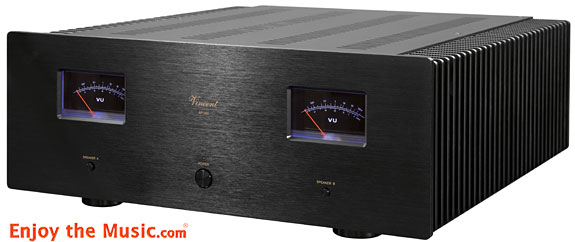
Almost every month I see Vincent Audio within the Audio Advisor catalog sent to my mailbox. But of course, there are other retailers that sell Vincent audio components. Just to name two, you can check out Upscale Audio and of course Amazon too. The Audio Advisor is certainly not the only U.S. distributor for Vincent Audio, yet they do move quite a bit of German audio products. The Vincent Audio trademark was registered in 1995 by the parent company Sintron Vertriebs GmbH (Germany). Although the SP-332 stereo solid-state amplifier as reviewed here is the latest iteration of the Vincent Hybrid amplifier line, it was in fact preceded by two earlier versions. First was the SP-331, and later the SP-331MK amplifiers.
The Subject
Vincent’s original SP-331 hybrid power amp has been part of this company product line for many years. Those two forerunner amplifiers’ technical specifications are similar to the review subject SP-332. All three versions are specified at 150 Watt per channel into 8 Ohms. The SP-332 is classified as a hybrid amplifier because in addition to a solid-state FET (field effect transistor) output stage, this amplifier utilizes three subminiature vacuum tubes as well. The amplifier power supply contains a 500 Watt toroidal transformer to ensure there’s an abundance of electrical power for the internal circuitry. This provides the necessary power along with a reserve capacity of 80,000 µF.
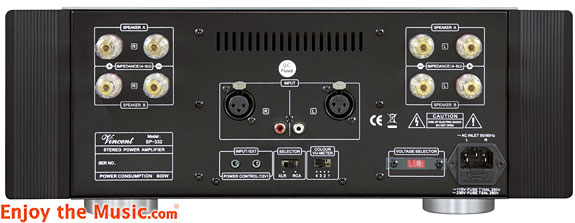
Up front stabilization of the B+ voltage is handled by a 6N15 tube. Inside the SP-332 are two 6N16 tubes working in a differential push-pull design within the input stage. The new Vincent SP-332 stereo amplifier is intended as an enhancement of the company’s SP-331MK. It was upgraded by providing both balanced XLR inputs and unbalanced / single-ended RCA inputs, both are selected via a rear panel switch.
The SP-332 also has dual speaker outputs, which can be individually selected on or off using one of the illuminated front panel push button switches. Actually the two push button switches are designated as, speakers, A and B. The A switch controls the top set of speaker binding posts and just under those are the B speaker binding posts. This enables a switch to two different sets of speakers or you can bi-wire one set of speakers. (Caution: Do not try to externally strap the A and B pairs of speaker connections together!)
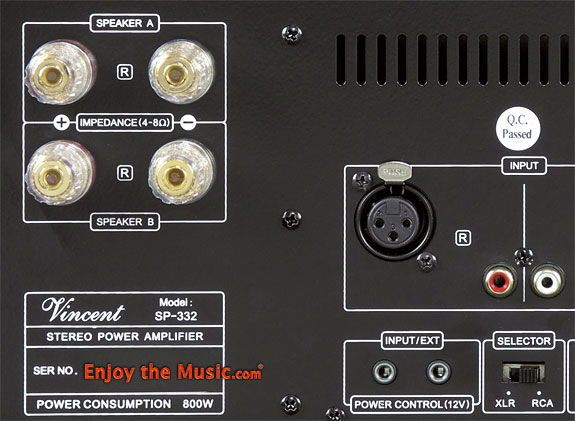
The most striking added feature is a pair of illuminated front panel VU meters. The new SP-332 includes Left and right channel VU (Volume Units) output meters. The meters have a selectable colored back-lighting scheme that simultaneously changes the color of the LEDs A and B speaker selection push buttons. You have the option to switch between red, blue, green, or white. Backlighting is selected using a sliding switch on the back panel. (I really like this feature) The amplifier is available in two finishes, anodized all black or black with an aluminum colored front panel, with a suggested retail price of $2199.
Plug It In
The SP-332 comes at you nicely double boxed, and at 46 pounds I can lift and fit it into my reference system. My initial/first impression is that the amplifier was manufactured to meet a specific price point. The back panel connections for RCA and XLR input cables are adequate and sturdy. The chassis enclosure is again OK, but that’s not where the German Sintron Company spent their money. You can find much more of that money on the inside. I am impressed by that large toroidal transformer within the power supply, as there is 80,000 mf capacitance. Then add to that the eight power MOSFETs and the two rows of heavy-duty heat sinks. What’s really important, after all, is what they expended on the active circuitry. The Sintron people do not say anything about running the amplifier to break it in, though I let it pump out Pandora music while I walked to Starbucks and bought myself a latte.
And by doing so, adding even more time I found that the SP-332 slowly got better. Initially, I would have said the treble portion of music seems to dominate. But with some time invested the treble assumed a more logical balance and integrated better with the midrange. However, the bass seems like it’s holding back a bit. In addition, the performance space between my speakers gradually began to come into focus. And in the process, small details assumed a more defined space. I was better able to pick out and locate individual events on the stereo stage. Not only that, the stage gained greater dimension in width and depth. This impression remained as I played a variety of reference music.
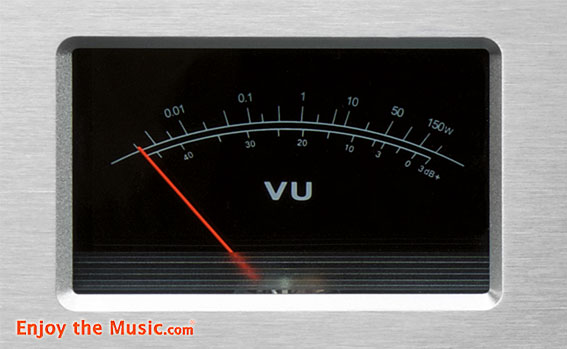
Empirically Speaking
In some former equipment reviews, I have said that there is not much point in telling readers about specific recordings that I listen to. Because they are recordings that you probably do not have, and they are auditioned on a system you do not own. But after some reflection, I reasoned that would be too broad a generalization. It is possible you just might have that specific recording I talked about. Furthermore, I don’t want to leave any impression that my personal critical listening is not important. And in that vein I would like to mention my purchase of a Doors vinyl double album, it is [Electra Weird Scenes From The Gold Mine]. It was in very good condition, I paid ten bucks for it at a flea market in Park Slope, Brooklyn N.Y.
Now understand I do have all the Doors songs on various media but the album art grabbed me. Having never seen this Doors cover before, the first thing I did was vacuum wash the disk before I spun it up. As I listened, was confronted by old man time because the studio mix sounded dated. There was a touch of that old left channel panning mix that is separated from the right channel. Center stage partially separated from either channel but with Jim Morrison firmly in the center. Now, this recording is far from ‘audiophile quality’, but still it tells a tale.
Mainly This: Listening to the distribution of the music energy as presented by the SP-332 stereo amplifier. It seems to predominate in the midrange and treble. Understand in my 12′ by 20′ foot listening space I am not into deep bass. Now you could add proportionately more bass presence/energy by turning up the volume. But to do it you have to increase the volume beyond polite apartment listening. Years ago I had AR 2AX speakers and I had that same symptom. No, it’s not my speakers! I have used more than a dozen different amplifiers with these speakers; the last one generated only 30 Wpc.
The 150 Wpc SP-322 should not have any low-frequency anemia. I will play a wonderful Clarity Cable compilation Demo disc given to me at the CES in Las Vegas. First track is a really great recording of Peggy Lee singing her signature song Fever. The very first note is a deep drum whack, following that and setting the tempo is a resonant plucked bass line. This acoustic bass line continues throughout the piece and provides the musical foundation to Peggy’s vocal artistry. The bass reproduction should be warm wooden and organic, nothing added nothing lost. Those very same natural/organic qualities will place Peggy Lee about eight feet in front of me alive and breathing. Unfortunately, once again there are deep bass details and overtones that are missing.
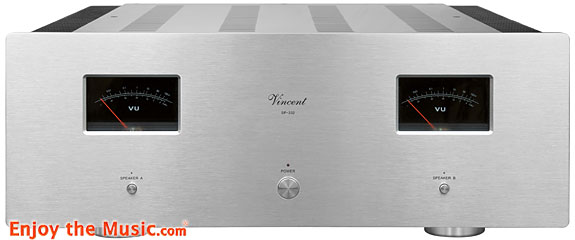
Analysis
Confounded, I wanted to see how the amplifier performed at all frequencies. My Rives Audio test CD has ten-second frequency bursts starting at 10 Hz up to 20k Hz. This is the results, at 31.5 Hz you start to hear a low rumble, at 50 Hz there is more appreciable output, but not until you reach 63 Hz do you have a sense that there is 150 Watts of bass power available.
Even though running a frequency sweep is totally system dependent and not exactly a laboratory standard test, I did learn something. The SP-332 can and does reproduce low bass frequencies so why are they less evident? The defining answer turned out to be that the amplifier still needed more time to burn in! I found this out in December and drove 380 miles to Gettysburg Pennsylvania to visit relatives. I left the system on playing a blue tooth Pandora music channel. Three days later returning to find a very warm to the touch SP332 amplifier. Even with Pandora still playing background music at low volume, I could hear that the amplifier had undergone an evolutionary improvement! The music sounded smoother, more refined. I was hearing a much better, integrated response, and additionally a slight high-frequency edginess was gone. If you were to plot a frequency response graph now, what you would see would be a far more flat and linear graph especially at bass frequencies. At softer listening levels the bass is now more proportionate relative to the mid and treble these are sometimes called the presence frequencies.
Let’s double-check and play that Peggy Lee CD once again. “Never know how much I miss you, never know how much I care”. Peggy, I do care, this is so much better. Now we have a three-part Trio, Drum, Bass, and Piano to back up the vocalist. Peggy Lee is front and center and finally, it is all there with nothing added and nothing missing. Consider that the Vincent SP-322 amplifier is priced at less than half of that 30 Wpc amplifier I mentioned earlier that retails for $4895. Obviously amplifier power cannot be the only determining factor, there is far more to consider.
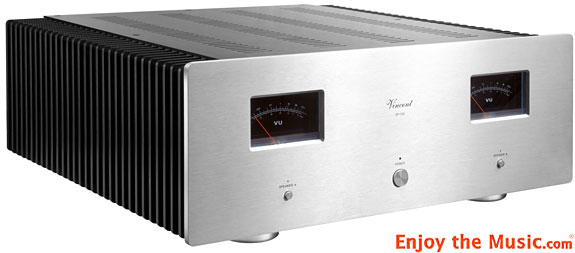
Coda
To be fair let’s place the SP-322 in its proper marketing slot around $2000. I would like to point out that personal preferences will be all over the place and are factored in when building an audio system. There really is no ‘one size fits all’. The midrange and treble are in fact extended, fast and articulate. That portion of frequency response will give you a clear window to discover subtleties buried deeper in the performance. With 150 Watts of power, you will be able to drive almost any speaker. At the asking price, it proves to be highly competitive within the range of $1000 and $2000 dollar solid-state amplifiers. Most certainly it deserves to be auditioned by you at home in your system.
Remember to enjoy the music, and from me Semper Hi-Fi.
Foot Note:
Earlier in this report, I mentioned three possible American sources that sell Vincent Audio components. I do not want to favor any one US retailer, and so I do not want to specify any one provider.
Reference System
Sources:
Reference Amplification: Sanders ESL Magtech power Amplifier, Prima Luna Prologue Integrated Amplifier.
Speakers:
Speaker Cables: Kimber Kable 12TC @ 11ft. And a Kimber Kable 8TC 18″ jumper to tweeter speaker.
Interconnect Cables: Monster Reference four pairs, two 0.5 meter, 1 meter and 1.5 meter, Nordost Red Dawn, Music Hall1 meter Phono cable. Chord Silver Siren 1 meter, Homemade Teflon RCA 1 meter, Autobahn 0.5 meter digital .
Power Conditioning: Wire World 10 gauge IEC line cord, Power Cords: Kaplan Cables 12 gauge IEC, Islatrol Industrial 20 Amp AC line conditioner, Richard Gray 20 amp Sub Station, Alpha Core Balanced Transformer Power Supply, and Audio Power PE-1 power enhancer.
| Tonality | |
| Sub–bass (10Hz – 60Hz) | |
| Mid–bass (80Hz – 200Hz) | |
| Midrange (200Hz – 3,000Hz) | |
| High Frequencies (3,000Hz On Up) | |
| Attack | |
| Decay | |
| Inner Resolution | |
| Soundscape Width Front | |
| Soundscape Width Rear | |
| Soundscape Depth | |
| Soundscape Extension Into Room | |
| Imaging | |
| Fit And Finish | |
| Self Noise | |
| Value For The Money |


Check out Enjoy the Music!
See many great reviews by Enjoy the Music.com at this link.
Specifications
Type: Hybrid tube and solid-state stereo amplifier
Frequency Response: 20 Hz to 20 kHz (+/-0.5 dB; 20 Hz to 50 kHz +/-2 dB)
Power Output: 150 Watts per channel @ 8 Ohms, 250 Watts @ 4 Ohms
THD:< 0.1%
Input Sensitivity:1.35 Volts
SNR:> 91 dB
Input impedance:47 kOhm
Vacuum Tubes: Two 6N16 and one 6N15
Dimensions: 16.8″ x 6.5″ x 17″ (WxHxD)
Weight: 46.3 lbs.
Price: $2199.99
Company Information
Vincent Audio
Sintron Vertriebs, Elektronic Import & Export
Sudring 14
D76473 Iffezheim
Germany
Voice: +44 07229 /
182950
E-mail: info@sintron.de
Website: www.vinvent-tac.de









Leave a Reply
Want to join discussion?
Feel free to contribute!